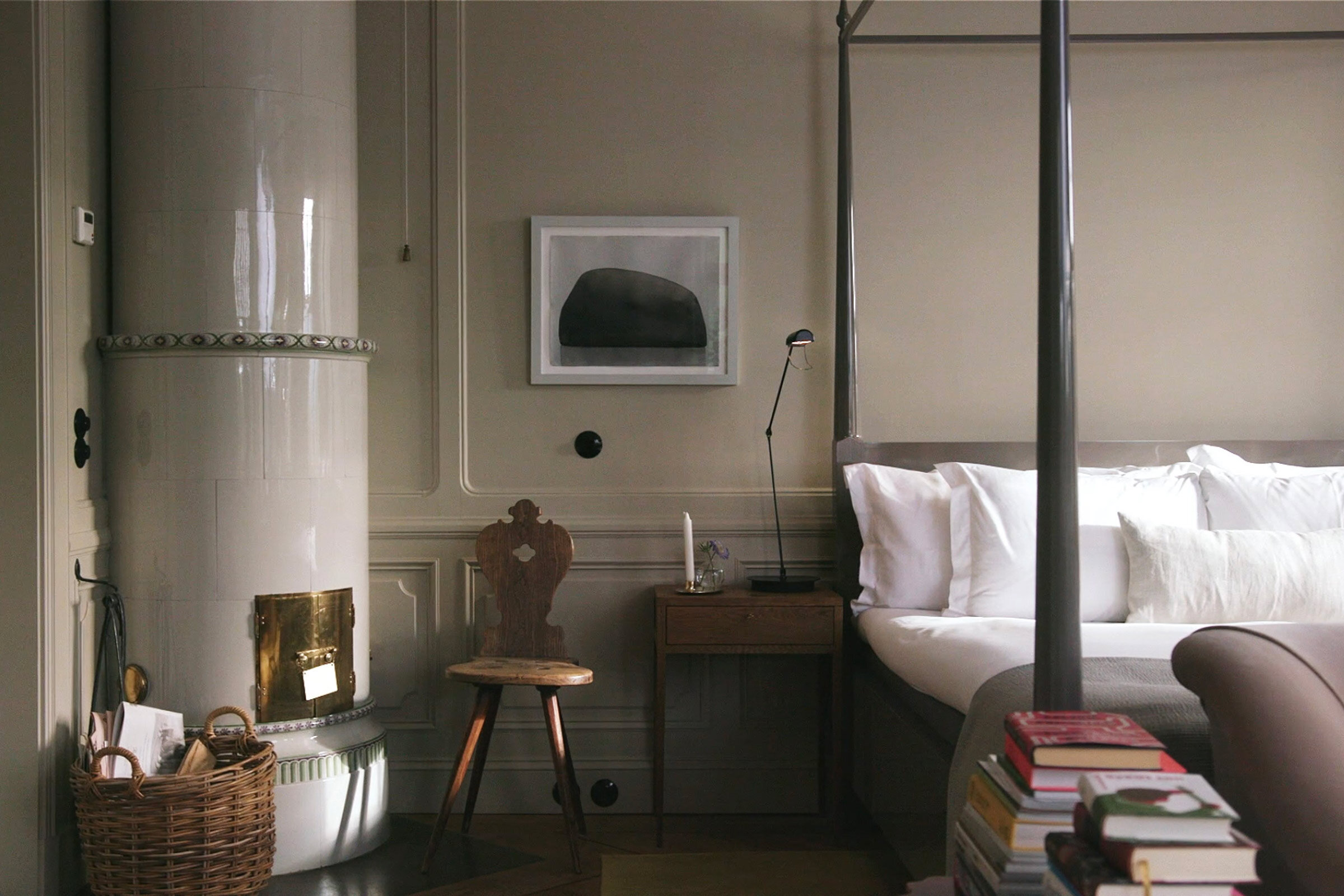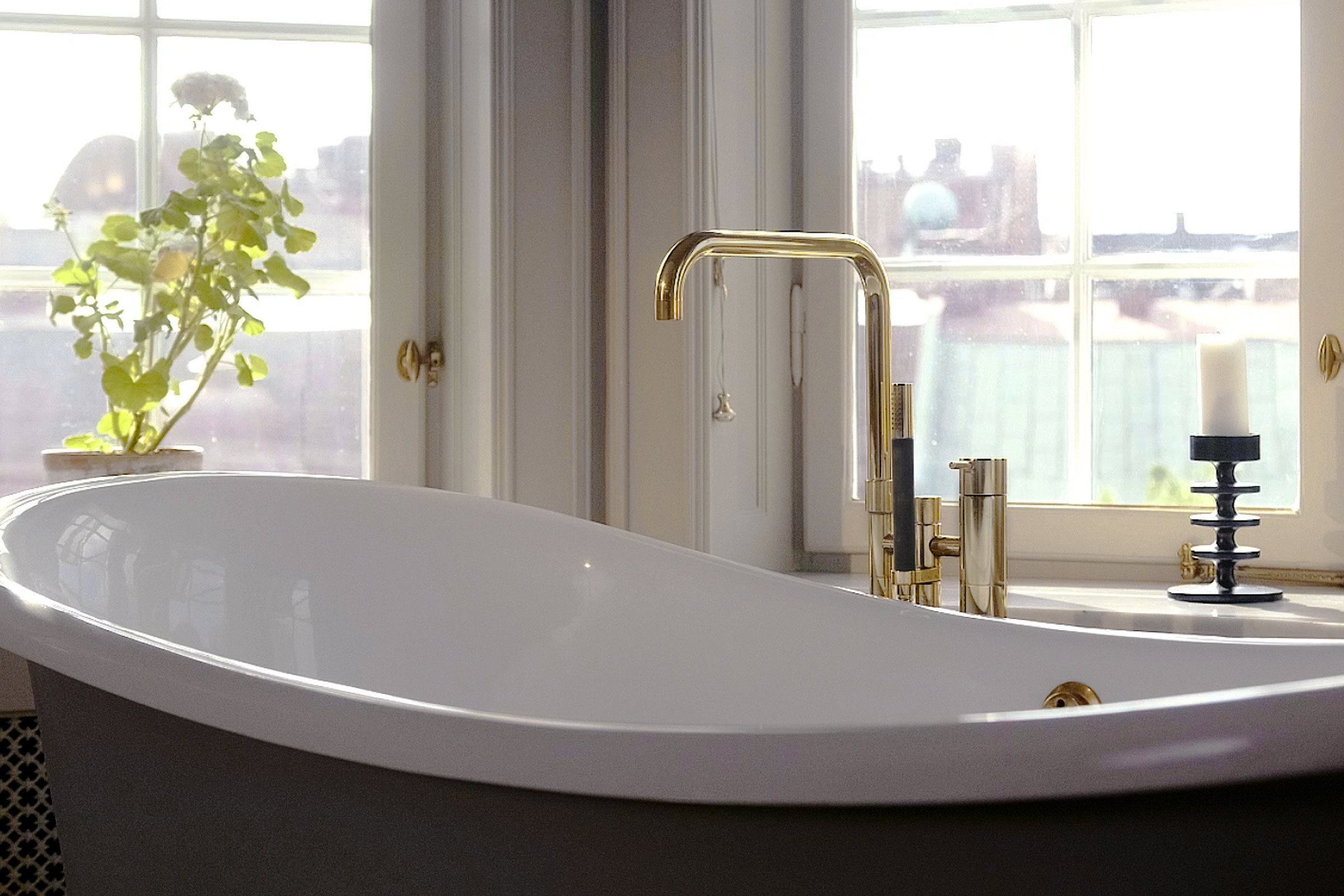‘Wellness and Wellbeing’ with Ilse Crawford
Danish brand VOLA’s short film ‘Wellness and Wellbeing’ is presented by award-winning British designer Ilse Crawford and filmed at Ett Hem in Stockholm
In Danish tap manufacturer VOLA’s short film Wellness and Wellbeing, award-winning British designer Ilse Crawford of Studioilse explores how design can enhance and support our daily interactions, behaviours and attitudes, as well as the important role wellness and wellbeing plays in design. With her Studioilse team, the former founding editor of Elle UK has designed spaces for the Soho House Group and Aesop, and designed sustainable furniture collections for IKEA.
Design is often associated with just form. A vehicle for something aesthetically pleasing or purely functional, and the interaction with the human aspect is considered the final step. Crawford couldn’t disagree more and proves this idea incorrect: ‘Before design, there is empathy. Without it, there is no good design,’ she says.
Crawford believes that wellness and wellbeing are of the utmost importance in design, focusing on understanding the real needs of people and the lives that will be lived within a space before even thinking about aesthetics. This understanding distils what makes us human and makes full use of our innate senses. ‘It’s important to design for the senses, because we are primal creatures and we read our environment through the senses,’ Crawford explains. ‘They are still what connects us to the world no matter whether we feel that intelligence is a more valuable thing. I believe our senses are another intelligence.’
Crawford is known not just for her outstanding design but also her ethos — as the former head and founder of the Man and Wellbeing department at the Design Academy Eindhoven, she taught students how to integrate humanistic values into design. ‘Good design is more than the way it looks. It’s about making sure the human experience is prioritised. It’s about wellbeing and making life better — not just for us, but for others and the environment. Man is not an island,’ she says. Wellbeing is at the core of her process, interpreted holistically as the importance of creating an environment that has a positive influence on us, our mood and our behaviour. ‘We spend eighty-seven per cent of our lives inside buildings, so how they're designed really affects how we feel and how we live.’
This attention to wellness and wellbeing is exemplified in Studioilse’s project Ett Hem, (‘A Home’), a truly unique hotel that encapsulates its name. Built in 1910 by architect Fredrik Dahlberg, it was originally the residence of a government official and his wife. Studioilse based much of the new layout upon old blueprints and drawings, from which most of the major spaces have been returned to where they were originally positioned. The team worked with great sensitivity and care to preserve Ett Hem’s personal quality and place that at the heart of the hotel. With Ett Hem, it wasn’t simply about creating a ‘homely’ hotel, it was about continuing the existing home’s story.
Common areas are a mix of outdoor and indoor spaces, creating a harmonious sense of togetherness, where a naturally friendly atmosphere emanates and boundaries between staff and guests dissolve. Guests feel that they’re staying with friends rather than at a hotel.
The building’s original owners filled the house with objects, artwork, textiles and furniture that have been reflected in how it stands today. Vintage and modern objects are mixed together, forming a collection of things that seem as though they have been curated over decades. Deep colours and tactile materials like velvet, wood, leather and brass provide a textural richness. Ett Hem is true to its Swedish culture, responding to the passing seasons, filling spaces with light and freshness in the summer, whilst offering roaring fireplaces, sheepskins and long baths in the colder months. The feeling of a warm welcome spreads throughout the entire stay and a sense of luxury deepens into a sense of home.
Ett Hem began with the question of how people can feel cared for and valued. ‘Hotels often offer a lot of services on the surface, but the only actual interaction taking place is putting in an order and receiving it on your bill. We based the concept on the idea of warm and intelligent human contact throughout and designed into that,’ Crawford explains. ‘The kitchen is shared by guests and the chefs use local produce and ingredients and are able to talk about that. We carefully selected sustainable brands and producers. We wanted to create a system where the money you spend goes back into good companies.’
Pieces were chosen not purely for their aesthetic qualities, but rigorously analysed for their material qualities, their durability, their comfort and ease of use and, ultimately, how it will make someone feel. As a result of this process, Studioilse’s interiors are authentic, soothing and human, and anything but superficial.
As we continue to live in a time of constant stress and overstimulation, more emphasis is placed on finding moments to slow down and feel grounded.
Through small, seemingly simple actions like turning on a tap, Studioilse creates moments that layer upon others to make life that bit more special, contributing to a true sense of wellness. For Studioilse, wellness and wellbeing goes further than just an ideal added to an end result. It’s about a much bigger system. It’s thinking about the environment, and the makers as well as the user. It’s focusing on where things come from, who they sustain, where they go; it’s how a piece is crafted and how it can change the way we live. The world we make will always be an expression of our values, but if you want to make matter matter, those values have to be embedded from the beginning to create a true sense of wellbeing.
Filmography / Chris Turner
Whatever it is, the way you tell your story online can make all the difference.
Whatever it is, the way you tell your story online can make all the difference.
Whatever it is, the way you tell your story online can make all the difference.
Whatever it is, the way you tell your story online can make all the difference.


























